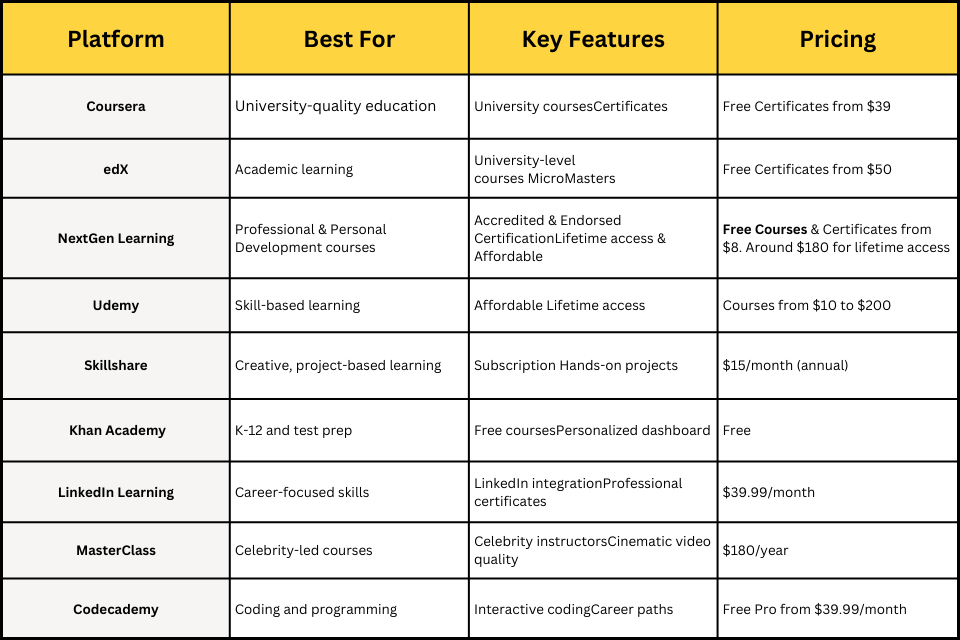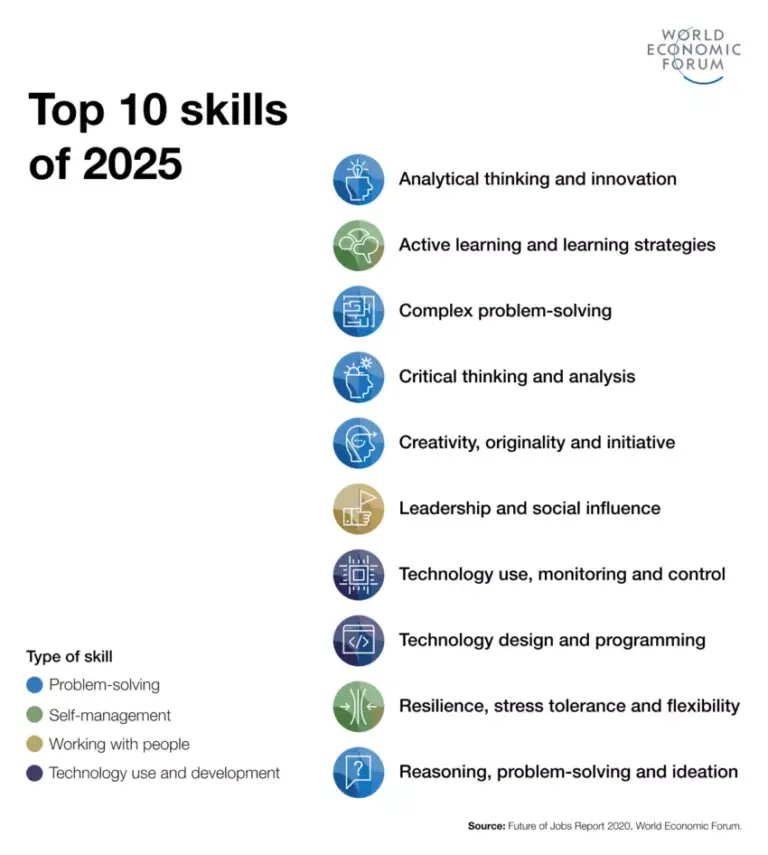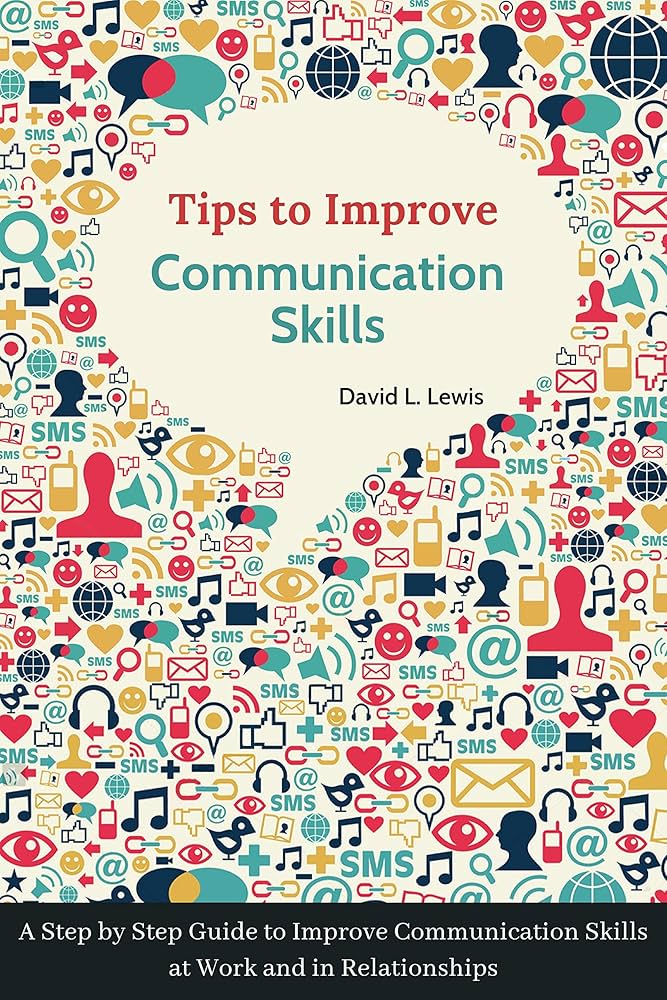A Comparison Of The Best Online Platforms For Skill Development

In a world where lifelong learning is the new norm, online platforms for skill development have become thriving hubs of knowledge. Surprisingly, over 60% of professionals globally engage with these platforms to either upskill or reskill. This trend underscores the growing importance of accessible education in an ever-evolving job market.
Online platforms like Coursera, Udacity, and LinkedIn Learning offer a myriad of courses tailored to various industries. Coursera partners with top universities and companies to provide courses that often come with certifications, enhancing credibility. On the other hand, Udacity is renowned for its nanodegree programs specifically designed to meet industry demands, while LinkedIn Learning integrates professional networking with its learning experiences.

A Comparison of the Best Online Platforms for Skill Development
Online platforms for skill development are crucial for anyone looking to enhance their abilities. Coursera, for instance, partners with universities and companies to provide top-notch courses. Udacity focuses on job-ready skills through its nanodegree programs. Another popular choice is LinkedIn Learning, which combines learning with professional networking. Each of these platforms offers unique advantages.
Accessibility and ease of use are major factors when choosing an online learning platform. Coursera’s interface is user-friendly, making learning enjoyable. Udacity, on the other hand, has a more specialized layout that’s effective for specific career paths. LinkedIn Learning benefits from its integration with professional profiles, allowing users to showcase their skills directly. This feature is especially beneficial for career growth.
The variety of courses available is another important factor. Coursera offers hundreds of courses in diverse fields like data science, arts, and business. Udacity focuses more on tech fields like programming and artificial intelligence. Conversely, LinkedIn Learning has a broad range that includes leadership, software skills, and creative disciplines. The choice depends on what skills you wish to develop.
Pricing and subscription models vary across these platforms. Coursera offers many courses for free, but certification requires payment. Udacity’s nanodegrees are costlier but come with greater specialization. LinkedIn Learning follows a subscription model, offering unlimited access to its courses. According to the article, any of these platforms could be ideal depending on your budget and learning goals.
Factors to Consider When Evaluating Online Learning Platforms
When evaluating online learning platforms, accessibility and user interface are essential. A platform should be easy to navigate, allowing users to find courses quickly. Coursera, for example, is known for its simple layout. If a platform is too complicated, users might get frustrated and give up. Thus, ease of use is vital.
The variety of courses offered is another critical factor. Look for platforms that provide courses in the areas you’re interested in. Udacity, for instance, focuses on tech-related courses. A broad selection ensures you can continue learning new skills without switching platforms. Course quality should be excellent too.
Cost and pricing models also play a significant role. Some platforms offer free courses but charge for certificates. Udacity’s nanodegree programs, which are more specialized, come with a higher price tag. Keep an eye out for subscription options. You might find it more economical.
Lastly, consider the support and community aspects of the platform. Some platforms offer forums and communities where learners can interact. LinkedIn Learning integrates well with professional networking. Others provide mentor support. According to this post, community features can enhance your learning experience.
Accessibility and User Interface
Accessibility and user interface are crucial elements of any online learning platform. A well-designed interface allows users to navigate easily and find the courses they need. Coursera is praised for its clean and straightforward layout. Simple interfaces prevent frustrating experiences. User satisfaction often depends on how intuitive a platform feels.
Different devices and operating systems also affect accessibility. Many platforms offer mobile apps, which let users learn on the go. Udacity has a mobile-friendly design that works well across devices. Being able to switch from a laptop to a phone makes learning more flexible. This adaptability enhances the overall experience.
User interface must cater to various learning styles. Some users prefer visual aids, while others like text-based materials. Platforms like LinkedIn Learning offer video, quizzes, and articles. Providing different types of content helps meet diverse needs. This variety ensures all users can find something that suits them.
Accessibility features are essential for all users, including those with disabilities. Features like screen reader compatibility and adjustable text size make learning more inclusive. Coursera incorporates these features, according to the article. Making a platform accessible to more people is not just good practice; it’s necessary. Accessibility can make a significant difference in a user’s learning journey.
Course Variety and Specialization
Course variety and specialization are important when choosing an online learning platform. Different platforms offer a diverse range of subjects. For instance, Coursera provides courses across various fields like arts, sciences, and business. This diversity allows users to explore multiple interests. It’s like having a library of knowledge at your fingertips.
Some platforms focus on specific industries to offer deeper specialization. Udacity is known for its tech and programming courses. Their nanodegree programs are designed to equip learners with job-ready skills. This targeted approach benefits those looking to enter specific fields. Specialization helps meet career goals more effectively.
Providing both free and paid courses is another advantage. Many platforms offer free courses with an option to pay for certificates. LinkedIn Learning operates on a subscription model, giving unlimited access to its courses. This flexibility accommodates different learning budgets. It makes education accessible to more people.
Interactive content keeps learners engaged and motivated. Platforms like LinkedIn Learning offer quizzes, projects, and discussions. These features enhance learning through active participation. According to this post, engaging content can significantly improve retention. Interactive elements make courses more enjoyable.
The ability to earn certifications is a significant draw for many users. Certifications can boost resumes and LinkedIn profiles. Coursera and Udacity often partner with reputed institutions. These collaborations add value to the certification. Having recognized credentials can open doors to new opportunities.
Some platforms offer unique courses that are hard to find elsewhere. For example, niche subjects like game design or specialized programming languages. These courses cater to specific interests. Such unique offerings can set a platform apart. It’s beneficial to explore what’s available to find the best fit.
Pricing and Subscription Models
One significant factor when choosing an online learning platform is how much it costs. Some platforms, like Coursera, offer free courses but charge for certificates. This model allows learners to access content freely while paying only if they need a certification. It’s a great way to learn on a budget. However, costs can add up if you want multiple certificates.
Subscription models are also common in online learning. Platforms like LinkedIn Learning use a monthly or yearly subscription. This provides unlimited access to the entire library of courses. Subscriptions can be economical for those who want to take multiple courses. It’s like having an all-you-can-learn buffet.
Udacity’s pricing model is different from others. They focus on nanodegree programs, which have a fixed cost. These programs are more specialized and often more expensive. Paying for a nanodegree can be beneficial for serious learners. It provides a structured learning path and recognized certification.
Discounts and scholarships are also available on many platforms. Coursera offers financial aid for those who qualify. Udacity has scholarships through industry partnerships. These options make learning more accessible. Keep an eye out for these opportunities to save money.
Here is a table comparing pricing models:
| Platform | Pricing Model | Special Features |
|---|---|---|
| Coursera | Free courses, paid certificates | Financial aid available |
| LinkedIn Learning | Subscription | Unlimited course access |
| Udacity | Fixed cost for nanodegrees | Industry scholarships |
Community Support and Networking Opportunities
Community support and networking opportunities are key benefits of many online learning platforms. Coursera, for example, offers forums where students can interact and help each other. These forums create a sense of community and enhance learning. Having a support system can make a big difference. It’s like having study buddies from around the world.
Platforms like LinkedIn Learning offer more than just courses. They integrate with LinkedIn profiles, allowing users to connect professionally. Networking with peers and instructors can open career opportunities. It’s a great way to build professional relationships. This integration adds significant value to the learning experience.
Interactive elements enhance community engagement. Udacity offers mentor support for its nanodegree programs. Mentors provide guidance and answer questions, making the learning process smoother. Engaging in discussions and group projects also builds a stronger learning community. Active participation leads to better understanding.
Many platforms host virtual events and webinars. These events cover various topics and allow direct interaction with experts. Participating in these events can expand your knowledge and network. They offer a chance to learn from industry leaders. Webinars are a valuable resource.
Here is a list of community features:
- Forums and discussion boards
- Professional networking integration
- Mentor support
- Virtual events and webinars
- Group projects
The availability of these features varies by platform. Choosing a platform with strong community support can enhance your learning experience. Engaging with a community can make learning more enjoyable and effective. It provides additional resources and motivation.
Key Players in Online Skill Development
Coursera is a significant player in online skill development. It partners with leading universities and institutions to offer high-quality courses. These courses often come with certificates, adding value to your resume. Coursera’s wide range of subjects makes it versatile. The flexibility to learn at your own pace is a big plus.
Udacity focuses on tech skills through its nanodegree programs. These programs are designed to be job-ready and industry-relevant. The content often includes projects that mirror real-world tasks, giving learners practical experience. Udacity collaborates with companies like Google and IBM for some courses. This collaboration ensures that the skills taught are what employers need.
LinkedIn Learning combines learning with professional networking. Users can add completed courses directly to their LinkedIn profiles. This integration helps in showcasing acquired skills to potential employers. LinkedIn Learning offers a broad range of topics including business, tech, and creative fields. Their subscription model gives unlimited access to all courses.
edX is another prominent platform created by MIT and Harvard University. It provides high-quality courses across various disciplines from top universities worldwide. Learners can access many free courses, although certificates require payment. edX also offers microdegree programs for specialized learning paths. These features make it an attractive option for continuous education.
Khan Academy focuses on providing free education for everyone, everywhere. It started as a platform for school-level subjects but has expanded to include various other topics. The user-friendly interface and interactive content make learning enjoyable. Khan Academy is especially popular among younger learners and educators.
Emerging Trends in Online Education
One of the biggest trends in online education is the use of artificial intelligence (AI). AI can personalize learning experiences by adapting to each student’s needs. Platforms like Coursera and Udacity are incorporating AI to recommend courses and provide real-time feedback. This helps students learn more effectively. Personalization makes online education more engaging.
Microlearning is also gaining traction. This approach breaks down complex subjects into smaller, manageable chunks. LinkedIn Learning offers many microlearning modules that fit into a busy schedule. These bite-sized lessons make it easier to absorb new information. They are perfect for people who have limited time.
Another trend is the rise of interactive and immersive learning experiences. Virtual reality (VR) and augmented reality (AR) are being used to create immersive environments. Platforms like edX are exploring these technologies to enhance course delivery. VR can simulate real-world situations for hands-on practice. This makes learning more dynamic and practical.
The popularity of bootcamps and short-term courses has also increased. These programs focus on job-specific skills and are often shorter than traditional degrees. Udacity’s nanodegree programs and other bootcamps are examples of this trend. They provide intensive training in a short period. This is ideal for rapid skill acquisition.
Social and collaborative learning is another emerging trend. Many platforms now include features like forums, group projects, and peer reviews. These elements make learning a more social experience. Engaging with peers can enhance understanding and retention. According to the article, community support plays a critical role in effective learning.
Subscription-based learning models are becoming more common. Instead of paying per course, learners pay a monthly or yearly fee for unlimited access. This model is used by LinkedIn Learning and other big names. It provides a more affordable way to access a wide range of courses. Subscriptions make lifelong learning more feasible.
Real Impact: Success Stories from Learners
Online learning platforms have transformed many lives. One inspiring story is that of Jane, a single mom who used Coursera to complete a business management certificate. This achievement helped her secure a promotion at work. Jane’s story shows the power of online education. It made her dreams more attainable.
Udacity has also been pivotal for learners like Raj. He completed a nanodegree in data science, which led to a job at a tech company. The practical projects in the course gave him the skills he needed. Udacity’s focused curriculum proved valuable. Raj’s success is a testament to specialized, career-oriented learning.
LinkedIn Learning has helped professionals like Emily, who wanted to boost her leadership skills. She took several leadership courses and applied the lessons at her current job. Her improved skills didn’t go unnoticed, leading to a significant salary increase. Emily’s story highlights the impact of continuous learning. It shows that skill development can lead to tangible rewards.
Alice, a teacher, found Khan Academy a helpful resource for her students. She used the platform’s free content to supplement classroom teaching. This extra support helped her students grasp difficult concepts. Khan Academy’s interactive lessons made a big difference. Alice’s experience shows how online platforms can also enhance traditional education.
Here is a summary of key success stories:
- Jane: Business management certificate from Coursera led to a promotion.
- Raj: Udacity nanodegree in data science resulted in a tech job.
- Emily: Improved leadership skills through LinkedIn Learning courses.
- Alice: Enhanced classroom teaching with Khan Academy resources.
These stories demonstrate the incredible impact of online learning. They show that with the right resources and dedication, anyone can achieve their goals. The flexibility and accessibility of these platforms make such success stories possible. Learners worldwide are benefiting from these opportunities.
Key Takeaways
- Coursera partners with top universities for diverse course offerings.
- Udacity specializes in tech skills through its nanodegree programs.
- LinkedIn Learning integrates professional networking with various courses.
- Each platform offers unique benefits based on user needs.
- Flexibility and accessibility are key advantages of these platforms.

Conclusion
Choosing the best online platform for skill development depends on your needs and goals. Coursera, Udacity, and LinkedIn Learning each offer unique features and benefits. Whether you’re looking for university partnerships, tech specialization, or networking opportunities, there’s a platform for you.
Online education’s flexibility and accessibility make it easier than ever to learn new skills. With diverse course offerings and supportive communities, these platforms can help you achieve your career aspirations. Embrace the learning opportunities available and take your skills to the next level.






